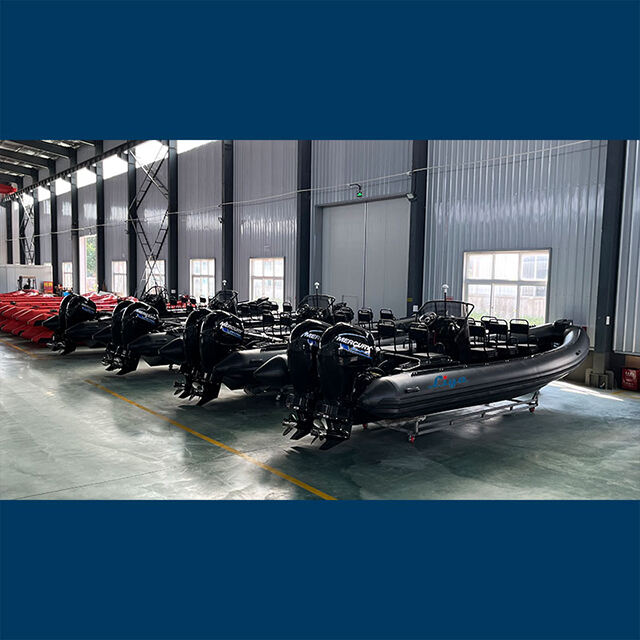Understanding the Strategic Impact of Modern Military Rigid-Hull Inflatable Boats
The evolution of naval warfare and maritime operations has brought the navy RHIB (Rigid-Hull Inflatable Boat) to the forefront of military tactical capabilities. These versatile vessels have transformed from simple support craft into sophisticated platforms that serve multiple critical roles in modern naval operations. Their unique design combines the durability of a rigid hull with the stability and buoyancy of inflatable tubes, creating an exceptionally capable maritime asset.
Today's military forces rely heavily on navy RHIBs for everything from rapid deployment missions to complex reconnaissance operations. These vessels have proven their worth in diverse environments, from the choppy waters of the North Atlantic to the challenging conditions of coastal defense operations in the Pacific theater.
Essential Features and Capabilities of Military RHIBs
Advanced Hull Design and Construction
The foundation of every navy RHIB lies in its innovative hull design. The rigid hull, typically constructed from marine-grade aluminum or advanced composites, provides exceptional performance in challenging sea conditions. This robust structure allows the vessel to maintain high speeds while offering superior maneuverability and stability. The inflatable collar not only provides additional buoyancy but also acts as a protective barrier during vessel-to-vessel transfers and docking operations.
Modern military RHIBs incorporate advanced hull technologies that minimize water resistance while maximizing fuel efficiency. The deep-V hull design cuts through waves effectively, reducing impact and improving crew comfort during extended operations. This sophisticated engineering ensures optimal performance in both calm and rough sea states.
Propulsion and Performance Specifications
Navy RHIBs are equipped with state-of-the-art propulsion systems that deliver impressive speed and maneuverability. High-powered outboard engines, often arranged in multiple configurations, provide the thrust necessary for rapid deployment and quick response scenarios. These vessels can typically achieve speeds exceeding 40 knots, making them ideal for intercepting suspicious vessels or conducting swift rescue operations.
The propulsion systems are designed with redundancy in mind, ensuring mission continuity even if one engine experiences difficulties. Advanced fuel management systems and efficient hull designs contribute to extended operational ranges, allowing navy RHIBs to maintain their presence in operational areas for longer periods.
Tactical Applications in Modern Naval Operations
Maritime Interdiction Operations
Navy RHIBs excel in maritime interdiction operations, where their speed and maneuverability prove invaluable. These vessels can quickly intercept and board suspicious ships, supporting counter-terrorism and anti-piracy missions. Their modest size and high mobility make them difficult targets while allowing them to operate effectively in confined spaces between larger vessels.
The versatility of RHIBs in interdiction scenarios is enhanced by their ability to carry specialized boarding teams and their equipment. Modern navy RHIBs feature integrated weapon mounting systems and advanced communication equipment, ensuring teams remain well-connected and capable during high-stakes operations.
Search and Rescue Capabilities
In search and rescue operations, navy RHIBs demonstrate their humanitarian value. The stable platform and excellent maneuverability make these vessels ideal for recovering personnel from water or conducting medical evacuations. Their inflatable collars provide a safer means of recovering individuals from the water, while the spacious deck area accommodates medical equipment and stretchers.
Advanced navigation systems and thermal imaging equipment enhance the search capabilities of these vessels, particularly in adverse weather conditions or during nighttime operations. The ability to operate effectively in shallow waters also makes navy RHIBs essential assets in coastal rescue scenarios.

Technological Integration and Modern Advancements
Navigation and Communication Systems
Modern navy RHIBs incorporate sophisticated navigation and communication technologies that enhance their operational capabilities. Advanced GPS systems, radar equipment, and electronic charts ensure precise navigation in all conditions. Integrated communication systems maintain constant contact with command centers and other vessels, facilitating coordinated operations.
The implementation of network-centric warfare capabilities allows these vessels to share real-time tactical information with larger naval assets. This technological integration transforms navy RHIBs from simple transport craft into vital nodes in the military's maritime information network.
Surveillance and Weapon Systems
Today's military RHIBs can be equipped with advanced surveillance equipment and weapons systems that extend their tactical capabilities. Stabilized camera systems, infrared sensors, and remote-controlled weapon stations enable these vessels to perform reconnaissance missions and provide fire support when necessary. The modular nature of modern RHIB designs allows for rapid reconfiguration based on mission requirements.
The integration of drone launch and recovery capabilities further extends the surveillance reach of navy RHIBs, allowing them to gather intelligence while maintaining a safe distance from potential threats. These technological advancements have significantly expanded the operational envelope of these versatile vessels.
Future Developments and Emerging Technologies
Autonomous Operations
The future of navy RHIBs includes developments in autonomous and semi-autonomous operations. Research is ongoing into systems that would allow these vessels to perform routine patrols, conduct surveillance missions, or even operate in hazardous environments with minimal human intervention. This technology could significantly reduce risks to personnel while maintaining operational effectiveness.
Advanced AI systems are being developed to enhance the autonomous capabilities of navy RHIBs, enabling them to make complex decisions in dynamic maritime environments. These developments could revolutionize how military forces utilize these versatile platforms in future operations.
Environmental Adaptations
As environmental concerns become increasingly important, navy RHIBs are evolving to incorporate more sustainable technologies. Research into hybrid and electric propulsion systems aims to reduce the environmental impact of these vessels while maintaining their operational capabilities. New hull coatings and materials are being developed to improve efficiency and reduce maintenance requirements.
Future designs may incorporate solar panels and advanced energy storage systems, extending operational ranges while reducing dependence on traditional fuel sources. These adaptations ensure that navy RHIBs remain relevant and effective in an environmentally conscious military framework.
Frequently Asked Questions
What makes navy RHIBs different from civilian versions?
Military RHIBs feature enhanced structural reinforcement, specialized communication systems, weapons mounting capabilities, and advanced navigation equipment. They are built to military specifications and often include additional features for tactical operations that aren't found in civilian models.
How long can a navy RHIB operate continuously?
Depending on the configuration and operating conditions, modern navy RHIBs can typically operate for 8-12 hours continuously. Advanced fuel systems and efficient designs can extend this range, while mission requirements and sea states may affect operational duration.
What is the typical crew size for a military RHIB?
Standard navy RHIB crews typically consist of 2-3 operators, though the vessels can accommodate up to 8-12 personnel depending on the model and mission requirements. This includes space for specialized teams such as boarding parties or rescue personnel.
Table of Contents
- Understanding the Strategic Impact of Modern Military Rigid-Hull Inflatable Boats
- Essential Features and Capabilities of Military RHIBs
- Tactical Applications in Modern Naval Operations
- Technological Integration and Modern Advancements
- Future Developments and Emerging Technologies
- Frequently Asked Questions

